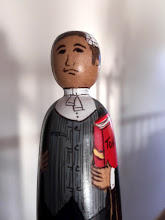 |
| A typical early 'toss shot'. |
It is 32 years since
I invented the selfie. Little did I know how the technique would sweep the
globe. How today, everyone has held out an arm to snap a shot of themselves,
sometimes even wearing clothes. How with a click of the finger it’s possible to
record yourself with friends, politicians, sportsman, actors, animals and food.
How the crude selfie-stick I made decades ago has developed into the slickest,
most high tech lengths of composite in the world. How the world’s first go-pro
that I fashioned with VHS and string has become small, robust and waterproof.
Thirty-two years. If it were a marriage it would be the diamond anniversary plus two. So it seems fitting to record how it all began. In this piece I'll reveal the story of the selfie's creation. Next week I'll write about how far the selfie has come and how a remote village in South America is challenging the world to return to the selfie's simple beginnings.
Thirty-two years. If it were a marriage it would be the diamond anniversary plus two. So it seems fitting to record how it all began. In this piece I'll reveal the story of the selfie's creation. Next week I'll write about how far the selfie has come and how a remote village in South America is challenging the world to return to the selfie's simple beginnings.
In the beginning, before I became a popular and respected barrister, I was an unpopular and troubled youth who spent many days and nights alone. I would play by myself and travel solo. Times were simpler than and kids made their own fun. One of my favourite things was to walk about the bush in summer looking for little rocks. I liked to pick them up and throw them at bigger rocks and sometimes trees. If there was a flat rock to sit upon while I threw the little ones at the bigger ones, then that was even better. Sometimes, if there was water about I would skip flat rocks across the surface and off into the distance. One lucky day I found a great steel water tank that made an unworldly dzingggggg sound when the right sized rock ricocheted off it.
When I was older I’d walk or ride
around with a camera, taking photographs of the rocks and trees. The further I
travelled the more photos of rocks and trees I got, and the more adventurous I
became. Soon I was recording whole landscapes: hills, valleys, beaches and
oceans. They were pretty but often quite boring images.
Then one day I got to thinking: something
in the foreground would help the composition and improve the photograph. I
needed foreground interest. Something small and familiar. A picnic basket or a wheelbarrow
for example. Trouble was, I almost never had a picnic basket or wheelbarrow
with me, although I once had a Vegemite sandwich wrapped in greaseproof paper
but that didn’t really work.
Then, Eureka! A bathtub full of water
would be an ideal addition to any landscape. I remembered that I had found one
once in a rain-soaked cow paddock and the resulting image was moody and
wonderful. But the same old problem arose: there just aren’t that many bath
tubs in the Australian bush and I never travelled with one in my kit.
 |
| All landscape images are improved by bathtubs. |
Then another Eureka moment. What I
needed in my foregrounds was something that I would always have with me. So I
began scattering items of clothing about the foreground. Some arrangements
worked better than others. My battered Akubra on a rock, boots by a tree trunk,
Johnny Howe singlet hanging from a branch, all worked a treat; Y-fronts, socks
and handkerchiefs scattered around like the remains of an exploded man didn’t
work at all. And, working naked meant that the risk of sunburn and arrest was
ever present.
Eureka - again. (Good things come in
threes)
 |
| I would be the foreground interest ... easier said than done. |
So I improvised. I knew my camera, a
mid-range 35 mil Pentax SLR had a clockwork timer. I could use that function if
only there was some way for me to get into the shot.
Then, Eureka. (What is the plural of
Eureka? Eurekas? Eureki?) I would set the timer, throw the camera into the air
with the lens facing down, pose, then catch the camera before it hit the
ground. Easy.
 |
| My next camera was a little Leica. |
Then
one day, after an afternoon of unproductive tossing, I left the camera where it
fell and sat down on a tuft of grass to watch the sunset and cry. Then,
incredibly, I heard the click. I looked back at the camera and saw the lens
pointing in my direction. I send the film to be developed and when the prints
returned I opened the envelope excitedly. There it was, the world’s first
selfie.
 |
| I left the camera where it fell and ... Eureka. |
Not satisfied with that I immediately
began experimenting with the technique. I used the timer and placed the camera
anywhere I could to achieve a well-balanced shot. I used rocks, the forks of
trees, picnic tables, road kill and once the head of a sleeping koala.
Then
came the thing that would change photography forever. While cycling the Great Australian Bite I picked up a discarded surveyors' peg, wired it to my handlebars
and stuck my Pentax to the end with chewing gum. The world’s first selfie-stick
photograph. Sadly that image has not survived, but the world’s second selfie-stick
photo has and next week I will share it for the first time.

No comments:
Post a Comment